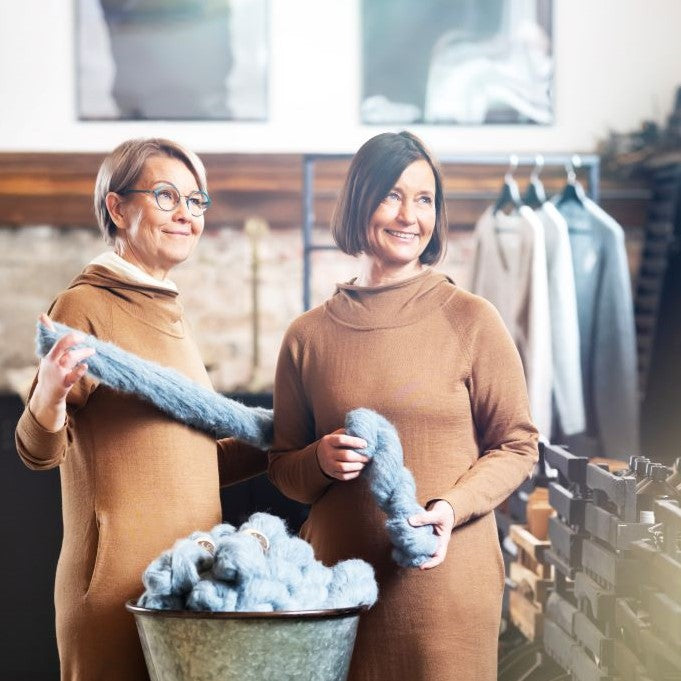



Sleeveless knitted vest pattern - Kolkuri
ONLY AVAILABLE IN FINNISH!
Hobo vest for women and men.
When a teenage boy asks his mother to knit a slipover, the signs are clear. This all-time classic has made a comeback. Cardigans are in fashion again! The stroller was designed by Ateljee Piia Maria in collaboration with Ruukki Kehräämö.
The hobo is a nice little knitting project that can be completed in a few evenings. Instead, you will enjoy the warmth of the vest for an evening, if only for another. This multi-purpose garment will certainly not stay in the closet to gather dust, but will go on Kulkur's journey towards new adventures.
The hobo vest is knitted with circular needles up to the arms. In the upper part, the front and back pieces are knitted separately as a layer. The vest can also be knitted as a two-color brioche, as in the boy's slipover. Both implementation methods are taken into account in the instructions.
The instructions have 5 sizes (XS-XL). The smallest size XS corresponds to a woman's size 34 and is also suitable for a child about 150 cm tall.
Sizes: XS-SML-XL
Materials:
Ruukkin Kehräämön 100% Alpaca, 300-340 m / 100 g or
Ruukkin Kehräämö Alpaca/Wild silk 300-340 m / 100 g or
Ruukkin Kehräämön Angora/Alpaca/Wild silk 300-340 m /100 g.
The adult model is knitted from off-white 100% Alpaca. A child
the model piece is knitted in brioche in two colors.
Thread flow:
When knitted as a single color patent knit: 200-200-300-300-300 g
Knitted as two-color brioche:
Color 1: 100-200-200-200-200 g
Color 2: 100-100-100-200-200 g
Needles: 5 mm (length 80 cm) and 4.5 mm (length 80 cm and 60 cm)
or by handwriting.
The instructions are delivered to you as a downloadable print version. You can buy printed instructions in the shop.
You can find more information about knitting brioche From Piia-Maria's blog.
The instructions are delivered to you digitally, as a downloadable print version, which you can print if you wish.
You will receive a link to the instructions immediately after payment. Once you have opened the link and downloaded the product, the right of cancellation ends.
Alpaca and angora yarns
Ruukki Kehräämö's yarn selection includes a variety of alpaca and angora yarns. Our yarn is made only from undyed alpaca and angora rabbit fibers. Alpaca fiber comes to the spinning mill from Finland, Holland and Ireland. We only buy Angora fur from Finnish producers.
Some of the threads are spun with a small amount of wild silk. The Kalahari wild silk is the only free-living wild silk butterfly. The cocoons left behind by these butterflies are collected from the Kalahari desert. In Finland, silk is dyed with natural dyes.
Ruukki Kehräämö's wild silk blend yarns, born as a result of product development work, are a unique product family, the likes of which are not produced by anyone else in the world. The colors of the threads are created naturally from different colored alpaca and/or angora fibers, as well as from wild silk dyed with natural substances. The fibers are mixed at the beginning of the production process in a way that no one else uses.
This unique production process enables color slides, optical color mixing and the production of yarn with a very vivid surface. The end result is a yarn that is impossible to produce by dyeing or in large-scale industrial production.
Our production volumes are small. Our goal is not mass production, but we invest in quality. Each batch of yarn is a unique work of art that is created as a result of creative work.
Our artisan yarns are the high-end products of the yarn market. The strengths of the yarn qualities in the selections remain in a certain range, but there is no permanent color chart. Each lot is unique.
Knitting instructions
So that charming yarns don't just remain treasures in the yarn basket, we offer our customers knitting instructions designed for Ruukkin Kehräämö yarns.
Our knitting instructions are adaptable. The same instructions are also suitable for several different threads. The professionally written knitting instructions are clear and tested. The clothes come in many sizes.
You can buy the instructions in the shop as printed, beautifully illustrated booklets or digitally in our online store.
The knitwear is easy to maintain: keep, air and keep.
Store the sweater in an airy and dry place, protected from pests. The knitwear is refreshed and smoothed by clever steaming. The sweater can also be brushed with a clothes brush intended for delicate sweaters.
If necessary, stain removal and/or washing with wool detergent by hand or with the washing machine's hand wash program at +30°C.
Remember that we have a repair service. In case of damage, send your sweater to be repaired. This is how we together increase the useful life of knitwear and save nature.
And when your favorite sweater is completely worn out, we accept it as a material to be processed again.
1. Why don't we have any colorful knit wear?
Ruukkin Kehräämö's Alpaca Royal fiber is undyed. Each color is the true color of the original wool producing animal. Altogether, there are 22 basic colors of alpacas. This guarantees a wide and stunningly beautiful color palette.
Non-dyeing is an advantage of fiber, yarn and, above all, the finished knit. Harsh chemical processes; bleaching, dyeing, post-treatments and washing wear down the fibers and break their surface structure. The properties of the natural, minimally processed alpaca fiber are transferred directly to the garment. That's why Ruukkin Kehräämö's knitwear is not dyed.
When the knit reaches the end of its life cycle, the fiber continues its life. Undyed, non-chemically treated alpaca fiber is 100% biodegradable. Knitwear can also be torn back into fibers and recycled for reuse.
2. Why do our products have a delivery fee?
We want you not to make a hasty purchase decision, but to be sure of your choice when ordering the product. In Finland, up to 50% of e-commerce orders are returned. Postage has been found to significantly reduce the number of returns.
On average, the largest emissions of clothes sold in an online store come from the product itself (~83%), but transportation produces 14% of the emissions. If the product is returned, the transport emissions are doubled.
So we want to act responsibly both towards our customers and the environment. When you buy less, carefully and with better quality, the environment and your wallet will thank you.
Piqued your interest? Read more about the effect of transport on the emissions of an online store product.
3. Why don't we have discount campaigns?
We do not support fast fashion and quick purchase decisions. FOMO (Fear of missing out) is a commonly used method in marketing to get a customer to buy products that they don't necessarily need.
By limiting the offer to a certain time, consumers are tempted to make rash purchase decisions. Instead, we want you to be satisfied with your purchases from us and to use our products for a long time. You can always count on us to have the product at the same price, whether you make your purchase on Black Friday or a normal Sunday morning.
3. How can we guarantee that the yarn coming from Peru is responsibly produced?
In the mountains of Peru, alpaca breeding is the main livelihood. Up to 85% of the native population's income comes from selling alpaca wool. By buying wool from certain farms, we can ensure that the owner of the farm receives reasonable compensation for his work. Alpacas play an important role in breaking the cycle of poverty.
Ruukkin Kehräämö only uses high-quality and ethically produced, RAS-marked (Responsible Alpaca Standard) alpaca wool. Breeders belonging to Peruvian indigenous peoples tend their small herds with respect for nature. The organization we support, Quechua Benefit , helps the indigenous population to take care of the well-being of both the alpacas and their families.
For each batch of yarn that arrives at Ruukki Kehräämö, the fibers are collected separately from local small farms. Every fiber can be traced back to the premises and even to the animal. Growers get double the price for Alpaca Royal fiber compared to coarser fibers.
4. How can we guarantee that neither the angora rabbits nor the alpacas suffer during the wool picking?
Alpaca and angora rabbit are wool producing animals. They have been bred to produce wool, like merino sheep. Not shearing a wool-producing animal is harmful to the animal, because the wool does not stop growing at a certain length, but long and tangled wool makes it difficult for the animal to move and worsens hygiene.
We buy wool from angora rabbits only from domestic farms, where the spinning takes place under the conditions of the animals and stress-free. You can watch our partner Villiniity's coiling video and get to know angora rabbits in our blog post .
The Alpaca wool we use for our yarns comes mainly from domestic farms. We buy the black alpaca fiber from the Dutch Tienda Molino alpaca farm .
Alpaca wool must be collected with professional skill and as stress-free as possible for the alpaca and as gently as possible. Australian professional Chris Williams arrives in Finland in the spring and rolls the alpacas quickly and painlessly.
Choose options

















